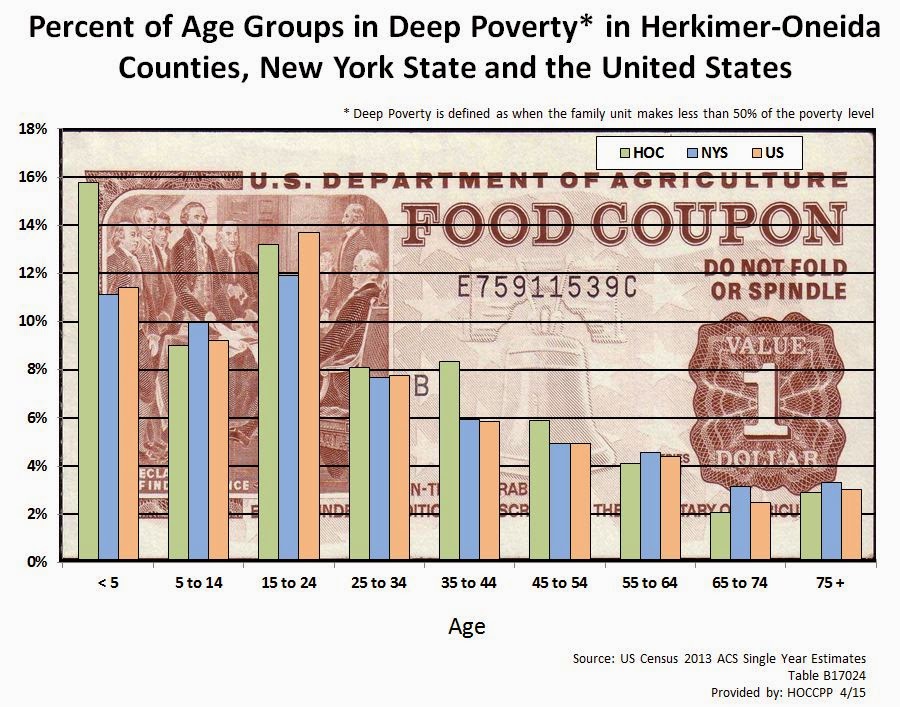 A day or so ago I posted about deep poverty and children in "deep poverty", "in poverty", and in "near poverty". Someone subsequently asked me about those living in "near poverty" so I wanted to share these findings.
A day or so ago I posted about deep poverty and children in "deep poverty", "in poverty", and in "near poverty". Someone subsequently asked me about those living in "near poverty" so I wanted to share these findings.For our purposes here, let's use the following for definitional purposes. Most government measures of poverty identify three levels, or depths, of poverty: "near poverty", "in poverty", and "deep poverty". Of course there is also that portion of the population that is above poverty.
"Near poverty" identifies, in this case, people who live in a family where the income level is between 150% and 101% of poverty income guidelines. So technically they are not in poverty at this time, but considered to be on the edge of poverty, or living in "near poverty".
"In poverty" identifies people where their family level of income is between the actual poverty level (100% of the poverty income level) and 51% of the poverty income level.
People living in "deep poverty" are those where families are at 50% or less of the poverty income guidelines. For these families, they are a long ways from getting out of poverty, hence the idea that they are seen as being in "deep poverty".
Below is a chart showing, by age groupings, the percent of population in "near poverty" for our region. These are compared to the state and national data in the chart. Click on it to enlarge the chart.
 |
| CLICK TO ENLARGE |
Of the roughly 277,000 people who have had their level of poverty identified in the region, some 28,000 live at the edge of poverty, or in "near poverty". The list below provides some insight into who they are, and how they live.
Ten Things About People Living In "Near Poverty"
In The Herkimer-Oneida Counties Region You Probably Didn't Know
- People living in “near poverty” are more than twice as likely to be Hispanic than those not in poverty. About 7.2% of those in “near poverty” are Hispanic while only 3.1% of people living above poverty have a Hispanic heritage. Interestingly, those actually living in poverty are even more likely to be Hispanic (9.2%).
- People living in “near poverty” are significantly more likely to be foreign born. More than one in ten (10.5%) of those in “near poverty" are foreign born. Only 9.0% of people living in actual poverty and 4.5% of the population living above poverty are foreign born.
- The population living in “near poverty” are significantly more likely to speak something other than English at home (16.6%). (In poverty – 10.7%; above poverty –7.7%)
- Unemployment for those living in “near poverty” is around 12% (In poverty – 29%; above poverty –5%)
- About one in three people living in “near poverty” are married (32%); one out of every four are either divorced or separated (25%). (In poverty - 21% and 29%, respectively; above poverty – 53% and 14%, respectively)
- About half (50%) of people living in “near poverty” worked in the last year. However as many as 42% haven’t worked in 5 years or have never worked. (In poverty - 34% and 48%, respectively; above poverty – 68% and 26% respectively)
- About one in five of those living in “near poverty” (19%) claim to have a disability. (In poverty – 26%; above poverty –14%)
- About 14% of all people living in “near poverty” are racially non-white. (In poverty – 26%; above poverty –9%)
- Nearly one out of five people living in “near poverty” are age 65 or older (19%). (In poverty – 9%; above poverty –20%)
- More than a quarter (28%) of those living in “near poverty” are children under the age of 18. (In poverty – 33%; above poverty –17%)
























